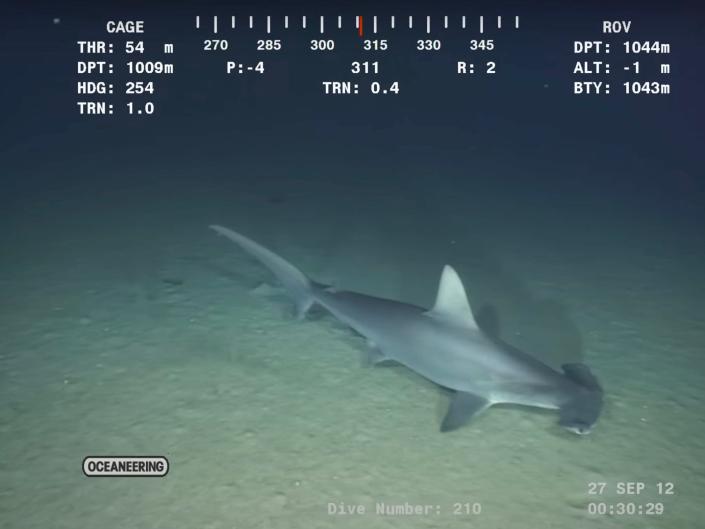Hammerhead sharks 'hold their breath' when deep diving up to 2,500 feet to avoid freezing to death

Views (146)

The way these sharks dive into almost freezing water has puzzled scientists. A new study suggests they can close their gills.
Hammerhead sharks are able to deep dive to frigid, near-freezing waters to catch rare prey.
But scientists have long been confused about how the cold-blooded animals survive such cold waters.
A new study shows the sharks can stop breathing during the dive to keep their bodies warm.
Hammerhead sharks can hold their breath to survive almost freezing-cold waters during deep dives, a study has found.
The scientists who led the study believe the sharks do so by clamping their gills shut to avoid cold water coming into their bodies, a never-before-seen survival strategy.
That means the sharks are essentially holding their breath for around 17 minutes while hunting.
Swimming in the right temperature water can be a matter of life and death for these animals because their metabolism, brain, vision, and muscles start slowing down if they get too cold. And if these sharks can't swim, they suffocate.
So how these animals manage to dive into water that drops to temperatures of about 40 degrees Fahrenheit (4.4 degrees Celsius) — practically freezing — has baffled scientists for decades.
"That is more than a 20-degree Celsius change in water temperature that these sharks are experiencing" in less than an hour's dive, Mark Royer, a shark physiologist and behavioralist from the University of Hawai'i told Insider.
For Royer, there's only one reasonable explanation: the sharks are holding their breath.
"For any animal that uses gills for respiration in the water, gills are like giant radiators strapped to your head," Royer said.
So the solution to keeping warm amid frigid waters is to keep the gills tightly shut.
The team's data suggests that the sharks close their gills before shooting almost vertically downward. They only open their gills once again about 1000 feet below the surface, when they slow their upwards ascent to catch their breath.
"That whole duration lasts an average of 17 minutes," Royer said.
"This is the first example we have ever seen of this breath-holding behavior to dive down into deep cold depths," Royer said.
While the strategy may seem risky, Royer said it's likely what gave the sharks their remarkable evolutionary advantage.
"Instead of having to compete with all the other warm coastal shallow shark species, they can extend their reach into the deep sea so that way they can hunt both shallow and in the deep sea when they want," Royer said.
These sharks have evolved to become athletes of the deep sea, carrying out dives several times a night, he added.
But there's a catch.
"The trade-off in this, of course, is that they need a recovery period afterward," Royer said.
"They'll hang out at the surface for about roughly 45 to 50 minutes. That's them kind of catching their breath," Royer said.
That may be why these sharks are more likely to die when they are caught in fishing lines or nets near the surface. At that point, any effort trying to escape a trap could be lethal, he added.
They may also become increasingly vulnerable as climate change alters the oxygenation of the oceans.
"For example, in the eastern tropical Pacific, there are expanding dead zones where the oxygen levels in the ocean are declining more and more as the years go on," Royer said.
"If these sharks are trying to hunt in that water, when they come up, there's that point where they need to open their gills back up to start breathing again. If that point gets higher and higher towards the surface, it's going to be a lot harder for this species to recover from their dive," he added.
Further research will look at how these sharks could possibly withstand such intense exercise without breathing, Royer said.
0 Likes
